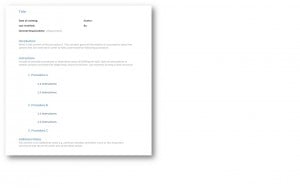The Importance Of Writing Down Your Work Process
- Home
- Info articles
- The Importance Of Writing Down Your Work Process

Development of Written Procedures and their Importance
This article is one of a series that will focus on the process of running a successful business. It covers business process techniques used at Whitehat SEO and is written by one of our in-house team members.
In current years more and more businesses have started to focus on documentation in their daily business activity. There are several reasons for this which will be explained further in this article.
Why do business avoid documentation?
The question often asked is why do many of the businesses in the UK work without any documentation or checklist? The first reason is clearly the time invested to create the documentations or checklists. A lot of business owners believe it is too much effort and time invested compared to the results achieved with a written documentation. Even though it can be time consuming to create a documentation that everyone can use, the saving of time later on is immense. This is due to the fact that everyone in the business is able to do certain documented processes, since they are explained step by step. This is especially a benefit for the business owner since he/she can focus on the core activities, instead of doing standardized task.
The next main reason why businesses avoid the documentation of processes is that they believe they do not need it in their company, since everyone knows what to do. However important steps can be forgotten (even though it is an expert carrying out the task). A checklist or a documentation makes sure the person carrying out the task knows where to start and that nothing is left out of the process.
Steps to Document a Processes

Important questions while creating documentations are: How do I create documentations? Gather information. At what time should I implement and make documentations? And how do I get my employees to use the written processes?
These are all major questions which I will try to answer in the next paragraph. First of all we will look closer on the term process.
What is a process?
The first important step, before making a written procedure is to identify the process itself. With having strict rules that set guidelines of how to identify the process it will be difficult to make a written procedure.
A process is a defined course of action that should bring forward a desired outcome or output. It consists of a couple of activities that are supposed to bring a specific outcome like for example adding a new client on to the online accounts system or how a sales person deals with a new customer enquiry.
Organisations have to identify their current objectives and then build up their process upon these objectives.
Writing Documentation
A procedure is only needed when there is a process. Sometimes there is no need for a documentation when the process is very simple, self- explained or general knowledge. Most employees would even feel that they are been made fun of if there is a procedure for how to turn on the computer (except when it is a very difficult process to turn on the computer).
Try to include the writing of the documentation as early as possible in the business process. It is better to start from day one. In the beginning it will be much easier to identify the processes, since the organisation itself is less complex than after some years of business activity. Later on it will also be easier to identify the evolving processes and include them directly. Also it will be easier to implement a standardised procedure of writing documents. Employees will be less reluctant to write these procedures when they are asked to do so from day 1 instead of doing it after 3 or 4 years of business activity.
When it is decided that there is a need to have a written procedure the organisation has to choose a person to write the documentation. Some businesses might think to assign one person within the organisation that is in charge of writing all the documentations, others might want to outsource the activity to specialised businesses. Usually it is recommended that the person doing the task at the moment or the expert for this task or process writes the procedure. There is no reason why an employee from the production department is writing a documentation for the HR department, or why third parties from outside should explain an activity they never have done before.
If the suitable person is chosen he/she has to select the content for the documentation. The content are all the steps included to fulfill the task in a satisfactory way. The writer should, before writing the final version, first do the activity while taking notes of the most essential steps. Then the author has to use step by step explanation, based on the notes, to explain the purpose of the procedure. There should be a use of bullet points and points should have numbers to form a clear structure. The explanations are supposed to be as short and as precise as possible. If it is a complex procedure, it is recommended to implement examples or pictures which illustrates and help the reader to get a broader understanding.
The purpose of the procedure has to be kept in mind at all points of the creation. It might be interesting for the author to include extra information, but if this does not follow the purpose or support the outcome it should not be in included. This only extends the length of the documentation unnecessary.
The last step and maybe the most important step is to encourage employees to use the documentations. First of all management should show the benefits (named above) of using documentations to employees. An example for a benefit is the time saving for employees. For example it is quicker for a new employee to read the procedure and then ask the remaining questions to a colleague, than asking for everything and maybe waiting for the colleague to have time to explain. This is also a benefit for the existing workforce, since they do not have to spend as much time on explaining and they are able to focus on their main activities. If there is a marketing expert, an seo expert or a marketing department within the company available it is a good suggestion to include them into “selling” the idea of written documentations.
Employees should also actively be engaged in the creation process. A good starting point is to ask them how they would design the layout or the creation of a rotating team (from different departments) testing new written procedures and giving their feedback.
The marketing resource engaged in this process can use the ideas created of employees for example the layout or content. Employees will adapt the ideas much easier when they for example get a small colourful checklist for making good procedures, which they have been contributing to develop.
For more information about how to write procedures that employees actually use, take a look at these five steps: http://www.sweetprocess.com/how-to-create-amazing-non-boring-procedures-that-your-employees-will-actually-use-to-get-tasks-done-correctly/
Typical Errors of Documentation
- Employees tend to use their technical terms when writing the procedures down. Try to avoid these, since it creates difficulties for other employees to understand the steps. My suggestion is to keep it easy.
- Often there is no standardized structure given for the documentation. This makes it difficult to keep on track for the reader. I would recommend to create a template of your standard layout which every employee should use. This should be applied by the whole company, no matter of their role or position. (an example of a layout see picture 1)
 Picture 1: Example of a layout for a written procedure
Picture 1: Example of a layout for a written procedure
- Gaps can occur when procedures are written down. This causes no connection within the steps, since the author is jumping from one point to another. It is not possible to go from A to C without explaining what should be done under the point B. This can also cause major mistakes and can lead to increased costs. These errors are often caused then the documentation are made in a rush our under time pressure. Another simple reason can be that the person writing it did not read the document after the creation. I would therefore recommend following steps:
- Read the documentation more than 2 times. Do not do the re-reading on the same day. I would recommend to put the documentation away for a couple of days and then print it. Then take a pen (preferable in red) and check spelling mistakes, take away unnecessary parts or add more detailed explanation. It is much easier to spot unclear phrases on a piece of paper and to mark them, instead of reading them on a screen. Be critical when correcting the documentation.
- When you think you are done with the documentation, give it to a colleague. The best is if you give the documentation to a colleague from another field than your own, since he/she will have another view on the written procedure than somebody from the same department. If you for example are from the finance department give the document to somebody from the marketing department. Ask them for critical feedback and ideas for improvement. If the colleague understands the documentation and is able to do the task, then documentation can be used within the company. Remember the whole idea of creating written procedures is to enable everyone to do the task.
- The last error that many business owners do not even consider are updates of the documentation. Most people consider the documentation completed after the steps named above. Often they do not take the changing business environment into account. It can also simply happen that you change a business procedure, since you might save cost or time. If updates are not considered major mistakes can occur and immense cost can show up.
My Own Experiences With Written Procedures
When I started as an intern at Whitehat, I was told the first day that the business works with written procedures. To be honest I was sceptical if this could work out. In my view it is difficult to include everything needed for a task on one piece of paper or in a Word-document. I also thought that it can be complicated to explain your mind set to another person.
As the first week passed by I realized these written procedures were not a bad idea. I was supposed to be the replacement for the current intern. The current intern was supposed to show me everything she had done until now, so I would be able to take over her task the days she left. The intern mostly showed me what she had been doing by documentations. She told me to read the documentation and then tell me if there was something I did not understand or if I had ideas of how to improve the documentation. Most parts of the documentations were simple and understandable. When I did not understand something I asked the intern what she meant by this. I also had some ideas for improvement. For example extending some of the explanations to tell more in detail of the for instance spreadsheet or cutting down some phrases to make it more simple. When the next intern is coming I will do the same, since I already mentioned continuous improvement of the documentation important.
Current Stories
There are several businesses successfully applying the documentation system to their daily business operations. One of them is Centratel. The company is a telecom company that is located in Oregon (USA). The owner of the business, Sam Carpenter, has written a book about the written procedures in his business. In the book he is explaining the way from no documentation and the struggles the company had until he started to realise that written procedures were needed. The company had these struggles since there were no clear guidelines to employees. Another reason was the CEO himself. He was carrying out major parts of the task, because he was not sure if somebody else could do it or deliver the expected quality. Through the implemented procedures he was able to make sure that employees knew what to do and that the outcome had a set standard. This standardization led to a drop in workload for the CEO and employees felt more motivated since they gained more responsibilities.
Summary
To summarize the key aspects of written procedures there should always be an analysis if these are needed for a specific task. When this consideration has taken place and a documentation is needed it is of high importance to do this in a standardized way, following the steps given above. If these guidelines are followed documentations can lead to improvement of performance and make the daily operations easier.
Contact our professional inbound marketing agency today, and get a FREE consultation on how to strategically invest in your digital marketing.
Send us an email now at info@whitehat-seo.co.uk or call us at (+44) 020 8834 4795 and grow your bottom line through our online marketing expertise today.
References
- https://books.google.co.uk/books?hl=en&lr=&id=nnVDSYneBeQC&oi=fnd&pg=PR5&dq=prozessmanagement&ots=cD_m5zEjJF&sig=m0Z-Ynzjm-f6whlpvSfoCUN33UI#v=onepage&q=prozessmanagement&f=false
- http://www.fu-berlin.de/sites/prozessmanagement/
- http://www.diplomarbeitsboerse.info/wp-content/uploads/WS-2010-Prozessoptimierung.pdf
- https://www.gov.uk/taking-disciplinary-action/overview
- http://www.mindtools.com/pages/article/newTMC_78.htm
- http://www.wikihow.com/Write-a-Standard-Operating-Procedure
- http://www.hse.gov.uk/humanfactors/topics/procinfo.pdf
- http://www.sweetprocess.com/7-reasons-why-writing-a-procedure-for-your-business-is-actually-profitable/
- http://dij.sagepub.com/content/43/1/69.full.pdf+html
- http://www.projektmanagementhandbuch.de/add-on/prozessmanagement/
- http://www.horvath-partners.com/de/kompetenz/funktionale-kompetenz/organisation-prozesse/prozessmanagement/

